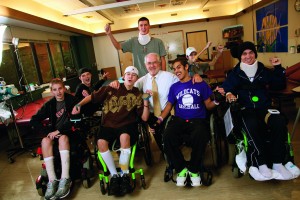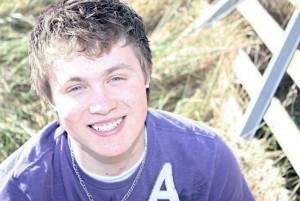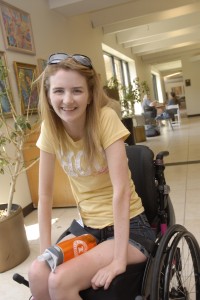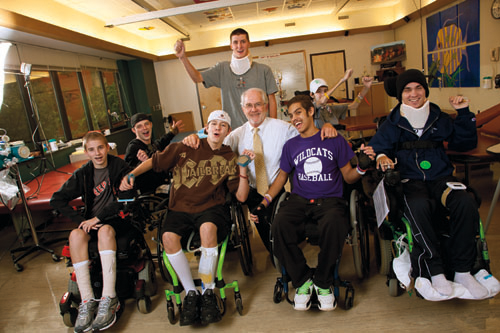
Dr. Herndon Murray (center) with Cody Holder (third from left in brown shirt) and patients. Photo by Billy Howard
Connor Whitesell, 17, was riding his dirt bike and wanted to try out a homemade ramp.
Cody Holder, 16, dove into a shallow pool at a relative’s house – despite his father’s warnings.
Kristyn Osterhaus, 19, was joyriding -- without a seatbelt -- in the backseat of an overloaded Jeep, following a summer party.
The three teens were from different parts of the country, and by all accounts, were good kids. Had they shown a tad more judgment in the moments leading up to those acts – perhaps had they just thought for a moment before acting -- they would have nothing in common. Instead, they are alumni of Shepherd Center, a spinal cord and brain injury rehabilitation hospital in Atlanta.
The riskiest summertime behaviors kids participate in don’t always involve drinking or drugs or sex. Sometimes, they are good kids being kids, and kids don’t always think through the consequences of their actions.
“Doing anything with a dirt bike is a risk,” Connor said. “I knew that. Going off a jump, like that, I knew there was a chance I could get hurt, but I never thought I’d break my neck. I wore all the proper equipment – racing pads, gloves and helmet. But the outcome was not the greatest.”
Connor, from Bluffton, Ind., loved being outdoors on his motorcycle. He has been paralyzed from the chest down since the April 2009 accident. Barring a medical breakthrough, he will never walk again.

Connor Whitesell
“My message to kids would be to have fun, do what you like to do, but think about the potential outcome,” Connor said. “Motocross is a sport, and it’s awesome. But you need to know what can happen and how your life and your family’s lives can be forever changed.”
Serious accidents such as the one Conner was involved in are an everyday occurrence. The National Highway Transportation Safety Board says that some 90,000 people were injured in motorcycle accidents in 2009. But the same government agency points out that nearly 2 million were involved in auto and truck accidents that same year. That helps explain why the University of California at San Francisco's Department of Neurological Surgery estimates that some 2 million people suffer brain or spinal cord injuries per year.
Rehabilitation centers that deal with spine and brain injuries are in at least 26 states. Some of the facilities are in very big hospitals, including the University of Alabama at Birmingham Medical Center, New York-Presbyterian Hospital and the University of Colorado Hospital. Others include Spaulding Rehabilitation Hospital in Boston, Craig Hospital in Englewood, Co., and the Rehabilitation Institute of Chicago.
Shepherd Center learned long ago that prevention was better than any treatment. So the center set out to educate kids and their parents – to at least cause kids to think before they act.
Staff members frequently do outreach in metro Atlanta schools, teaching about the risks associated with diving into any body of water. They talk about the importance of helmets when skateboarding or cycling. And they work with high school and college sports associations on the proper techniques for tackling and how to spot the signs of a concussion.
“For Dr. [Herndon] Murray and me, and all of us at Shepherd Center, it’s a personal mission to figure out how to aid in the message of prevention, particularly for our adolescent team,” said Shepherd Center therapy manager Shari McDowell.
Kristyn’s choices on the Fourth of July 2010 were poor. She knows it. She also knows that it’s the type of choice that thousands of kids make every year.
The Jeep she was riding in ran through a stop sign and hit a ditch. Kristyn flew through the air and broke her neck upon impact. There were at least seven people in the Jeep, she said. Kristyn remembers piling into the back, not really in a seat, and certainly not wearing a seatbelt.

Kristyn Osterhaus. Photo by Leita Cowart
“I know it’s bad to say; it’s OK for kids to drink,” she said. “And that’s not what I’m saying. But it’s going to happen. Kids are rebellious at ages 16, 17, 18 – no matter what they hear from a speaker. I’d heard all the lessons about not drinking and driving. Kids don’t listen to that message until it happens to them.
“I urge anyone to think about the consequences of what can happen if you make wrong decisions,” Kristyn added. “The decisions can affect you in major ways. It’s a hard lesson to learn. I wish kids would not have to learn the lesson the hard way. Look at pictures of someone like me. It could happen to you.”
Kristyn, from Paynesville, Minn., is paralyzed from the chest down, and again, barring a miracle, she’ll never walk again.
“It’s taken a lot of my mom’s time, taking care of me, redoing our house, paying for therapy,” she explained. “It’s taken its toll on my family for sure.”
Taking a stance against hopping in the back of a Jeep with six other friends -- many of whom had been drinking -- is an easy one. And while dirt bikes and skateboarding have their inherent risks, nothing gets the antennas up at Shepherd Center like diving.
“One of our big things here is, don’t dive. Period,” said Cathi Dugger, a spinal cord injury physical therapist. “But that is not a tremendously effective message. Last year, we had a lot of diving injuries. We sat down with a lot of the kids and asked them whether this message would influence kids. They didn’t think it would.
“But if we preach it enough, maybe they’ll jump first instead of diving,” Dugger added. “Maybe they’ll know what they’re jumping into. Dr. Murray’s not changing his message, though. That’s all he’ll say: ‘Don’t dive. Period.’ You won’t break your neck if you don’t dive. That goes for pools, too. The bottom of a pool rises up at the place where you might land if you dive too far. That’s a direct hit.”
Creeks, rivers and quarries are more dangerous than pools, Dugger said, because of the unknowns – such as, where are the rocks and how high is the water that day. Jumping into those bodies of water is dangerous. Diving is plain asking to be injured, she said.
According to the University of Alabama's National Spinal Cord Injury Statistical Center, about 11,000 people suffer spinal cord injuries each year. Of that number, around 660 are sports related, while more than 430 involve diving accidents.
Cody Holder, 16, of Manchester, Tenn., always the “thrill-seeker” of the family had jumped off bridges into lakes and didn’t see anything dangerous about a swimming pool. On June 22, 2009, in front of his parents, sister and cousins, Cody sprinted and dove as far as he could from one side of the pool to the next. He crashed into the side of the pool, was knocked unconscious and nearly drowned. His dad rescued him and brought him back to life through CPR. At that point, everyone thought Cody was going to be OK.
He was not.
“Diving into a pool, no matter what, is never a good idea,” Cody said. “I’ve seen many people dive off a board and hit the bottom. It’s just not the brightest idea. I wasn’t thinking about what could happen.”
Cody, who sustained a spinal cord injury in the accident, has regained feeling throughout his body and can walk a little bit with a platform walker. But like Connor and Kristyn, his injury has been traumatic not only for him, but for his whole family, he added.
But through a holistic approach to treating spinal cord and brain injuries, Shepherd Center works to return injured adolescents like Cody and other patients to productive and independent lives, said Shepherd Center Medical Director Donald Peck Leslie, M.D. The hospital’s programs not only include physical and occupational therapy, but also a wide range of recreational therapy opportunities to get people back into active lifestyles, he added.
“We have an incredible list of young people who are back to school, friends and life since being paralyzed Dr. Leslie said.
This story was funded in part by the Spot.us community.

Another way that people can drive safely, is to make sure that the vehicle is functioning properly. People who drive on bald tires, or brakes that need to be replaced will have a greater risk in getting into an accident. People need to make sure to check their vehicle at least once a month to make sure everything is working properly. When engine lights come on, drivers need to get it checked out to reduce the risk of stalling on the side of the road.
Thank you for writing the article about the dangers of spinal cord and brain injuries. I am Connor’s mother and can attest to the fact that life changes drastically after a severe accident. I have shared this link with many others. If reading it causes even one teen to avoid an accident, your written words are gold.